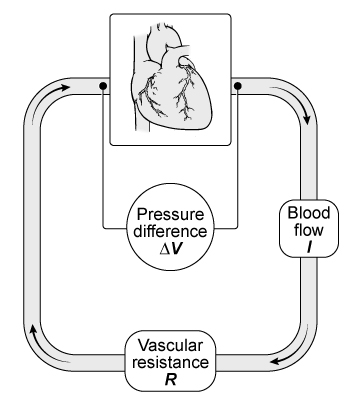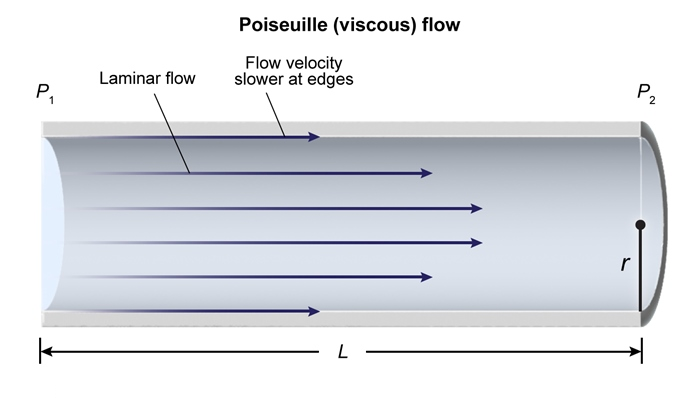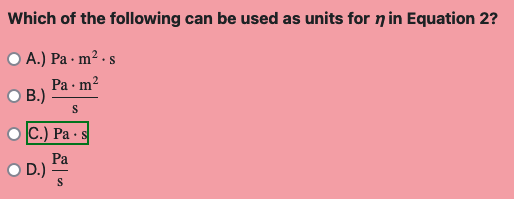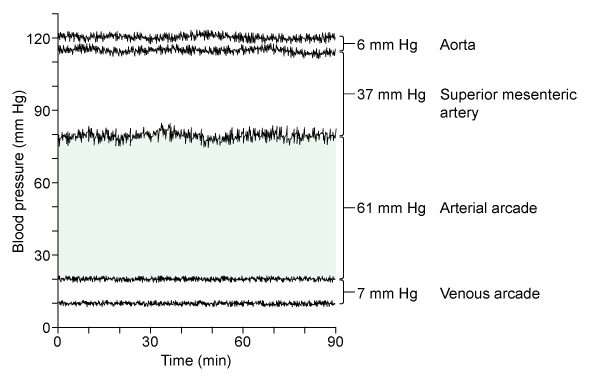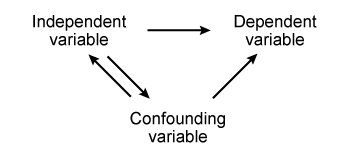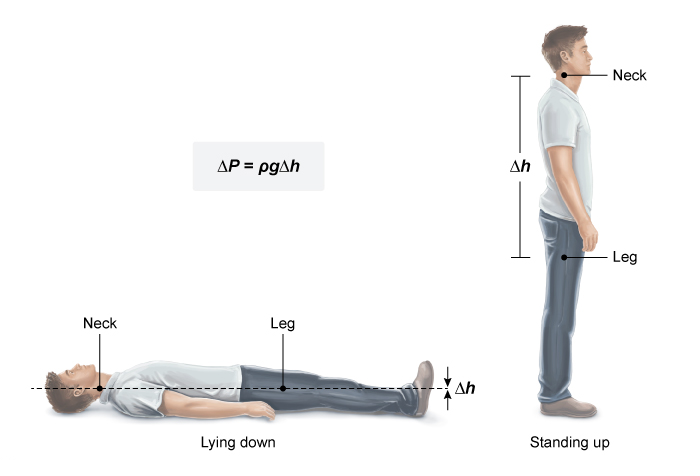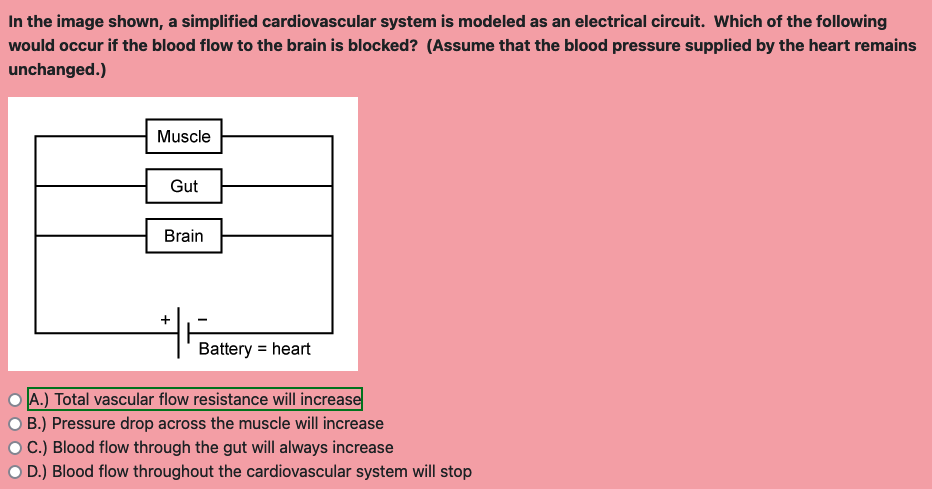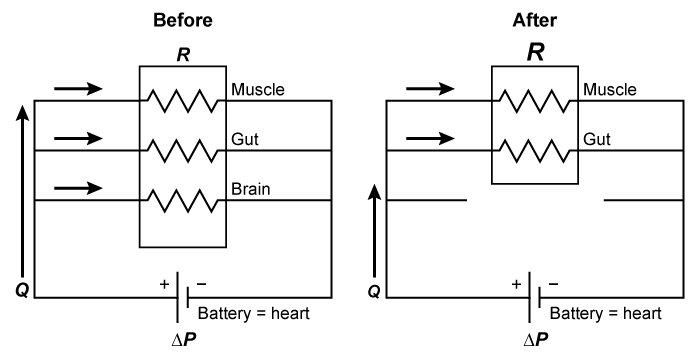Hemodynamics - And Combined Concepts
https://34353.org/wi/Physics/cd3d31cca41f66a4eb68645c4dabf854
Blood flow through the cardiovascular system can be modeled as an electric circuit :
- blood = electricity
- blood vessels = resistive wires
- heart = battery
Ohm's law states that the voltage drop across each element , the current flowing through it , and its electrical resistance are related by
In a blood vessel , we can replace the components of Ohm's Law with :
- = Pressure difference between one vessel and the next ( )
- = Volumetric blood flow ( )
- = Vascular Resistance
- Vascular resistance is due to the blood's viscosity ( ) and the dimensions of the vessel through which it flows.
- Assuming blood vessels are cylinders , can be approximated as :
- Where is the length of the vessel , and is its inner radius.
- If Equation 2 is combined with Equation 1 , the resulting equation is Poiseuille's Law :
- Poiseuille's Law describes the laminar flow ( no turbulence ) of a viscous , incompressible fluid through a pipe.
- The viscosity of a fluid measures the internal frictional force that resists the flow.
- A fluid is incompressible if its density and volume do not change appreciably due to changes in pressure.
- The greatest decrease in blood flow rate is achieved when the radius is reduced by a factor of 2 , because Poiseuille's Law has a fourth-power dependence on and a linear ( first-power ) dependence on all the other variables.
- The change in radius yields :
- Therefore , blood flow rate decreases by a factor of when the vessel's radius is halved.
- Poiseuille's Law is used to model fluid flow in pipes, assuming laminar flow of viscous and incompressible fluids.
- According to Poiseuille's Law, the flow rate is directly proportional to vessel radius and pressure difference, and inversely proportional to viscosity and vessel length.
The units of a variable in an equation can be determined from the units of the other variables.
Viscosity ( ) is used in Equation 2.
- However, the units of vascular resistance are unknown.
Because the units of can be determined from Equation 1 , the two equations are combined to eliminate
To determine the units of , the other variables are rewritten with their SI units of length ( ) and radius ( ) in meters ( )
- Pressure change ( ) in pascals ( Pa ) , and volumetric flow rate ( ) in cubic meters per second
Note , that and are dimensionless quantities ( they have no units ).
- Solving for and simplifying :
- Units of one variable in an equation can be determined by rewriting the other variables using their units and solving for the units of the target variable.
Vascular resistance is the resistance of a blood vessel that must be overcome for blood to flow ( Equation 1 )
Equation 1 can be rearranged to , showing resistance ( ) is directly proportional to the pressure difference ( ) and inversely proportional to flow rate ( ).
Because is the same for each vessel , is dependent ONLY on .
- Therefore , the vessel with the greatest has the greatest resistance ( )
All pressure measurements int he study were recorded during systole, the point of greatest pressure.
- Therefore, the pressure drop across a vessel is the difference between its pressure and the pressure of the next vessel.
These pressure differences are calculated in Figure 2.
The arterial arcade has the greatest pressure difference of , and therefore has the greatest flow resistance.
- The vascular resistance of a vessel is directly proportional to pressure difference and inversely proportional to volumetric flow rate.
- When the volumetric blood flow rate is the same in two vessels, the vessel with the greater pressure difference has the greater resistance to flow.
In an ideal experiment or study, any and all changes in the measured dependent variable are due to changes in the independent variable.
However, this model may not be realistic due to confounding variables.
- Confounding variables = uncontrolled variables that have an effect on the dependent variable.
Experiments should be designed to minimize the influence of confounding variables if they cannot be eliminated.
To determine the magnitude of any effect of a possible confounding variable on the dependent variable, and experimental group that differs in the suspected confounding variable is tested.
- In the study described int he passage , different blood vessels of rats ( independent variable ) were accessed through an invasive laparotomy procedure ( suspected confounding variable ) to measure mesenteric blood flow pressures ( dependent variable ).
- The inclusion of an alternative procedure that is minimally invasive or noninvasive but still measures mesenteric blood pressures would determine if laparotomy is a confounding variable by determining if differences are found in the measured blood pressures.
- A confounding variable is an uncontrolled variable different form the independent variable but that still has an impact on the dependent variable.
- The effect of a confounding variable can be observed by including a group that differs in the confounding variable.
The pressure exerted by the weight ( potential energy ) of a fluid is direclty proportional to its depth.
- This pressure is known as hydrostatic pressure.
The hydrostatic pressure difference ( ) between any two points in a fluid is found by :
- where is the density of the fluid , is the acceleration due to gravity , and is the vertical displacement between the locations where the initial and final pressures are measured.
When the person is lying down, the neck and the leg are at about the same height level , making negligible.
However, when the person stands up , the between the nexk and the leg increases significantly.
- The blood pressure difference increases due to the hydrostatic pressure of the column of blood from above the leg to below the neck.
- Hydrostatic pressure is the pressure exerted by the weight ( potential energy ) of a fluid.
- The hydrostatic pressure difference between two points in a fluid is proportional to the fluid's density , the gravitational acceleration , and the vertical displacement between two points.
The three biological components ( resistors ) shown in this model make a parallel circuit, and the heart ( battery ) generates the pressure difference ( voltage ) that drives the blood flow ( current ).
The equivalent resistance ( total vascular flow resistance ) will increase with the removal of a resistor ( the brain ) because it is in parallel with the other components.
The voltage drop across each resistor will be equal to that of the battery, which does not change.
The current through each resistor in a parallel circuit is related only to the intrinsic resistance of the resistor an dthe electric potential ( voltage ).
- Vascular resistance of the gut and systemic blood pressure both remain constant after obstructing blood flow to the brain, so blood flow through the gut does not change.
If this were a series circuit, in which the current flows only through one path, all flow would stop by blocking one element.
- Parallel circuits have more than one path through which the current can flow.
- For resistors in parallel, the voltage drop across each resistor is the same.
- The equivalent resistance increases if a resistor is removed.
- The current through each resistor in parallel is independent from the others, and the sum of each component current equals the total current.
#blood , #ohms-law , #circuit , #model , #equation , #flow
